


There is a movement these days to ban the display of any item that bears the likeness of a Confederate Flag. Perversely, such likenesses have been adopted by some as the symbol of hatred and racism. That is unfortunate, because it is an important symbol of our history. Eminent historian Bell I. Wiley summed up these sentiments in a speech given January 19, 1961, on the birthday of Robert E. Lee, renowned leader of the Southern Cause ...
It is inconceivable that Lee, if he were alive today, would advocate resistance to national authority or in any way abet social turmoil or racial hatred. Certainly he would staunchly oppose the use of the Confederate flag to cloak sordid causes and sheild unworthy persons. To him the Confederate flag was a symbol of suffering, gallantry, and heroism of the highest and noblest sort. He would be infuriated by the sight of self-seeking demagogues and wrong-thinking agents of bigotry, hatred, and violence wrapping themselves in this revered emblem in an effort to acquire acceptability and enhance their influence.
It is just as important to eliminate hatred as it is to maintain our heritage. This site supports the Heritage not Hatred campaign, with it's symbol the Bonnie Blue Flag. For those wishing to support this campaign, feel free to download and use the symbol appropriately, but please reference this page if you do so, and let us know your support.

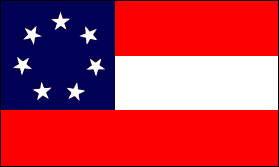 1st National |
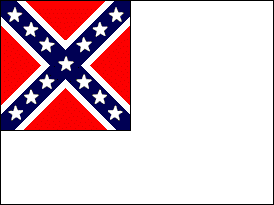 2nd National |
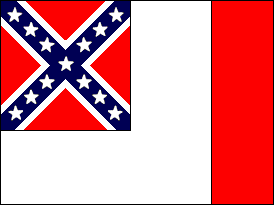 3rd National |
 Bonnie Blue |
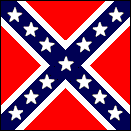 Army N.Va. |
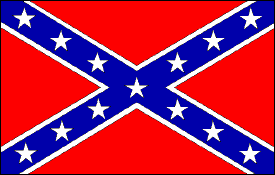 Navy Jack |
| Flags of the Confederate States of America |
The Confederate Navy Jack is often mistaken for the offical flag of the Confederacy. Only the Second National and Third National flags were ever officially adoped by the Confederate States of America. Approximately half of the thirteen states that made up the old Confederate States of America have state flags reminiscent of the Confederate National flags. Was this intended simply to acknowledge the heritage of an important period in their history, or to facilitate continued bigotry and hatred?
Two states have flags that incorporate the battle flag of the Army of Northern Virginia -- Georgia's includes it directly and Mississippi's includes it as the union on a field similar to that of the First National flag, except with blue, white, and red horizontal stripes instead of alternating red and white.
|
Georgia |
Mississippi |
Three states have flags also similar to that of the First National flag. Missouri's, like Mississippi's, has a field of red, white, and blue stripes instead of alternating red and white. North Carolina's flag appears as the top half of the First National flag and includes a single star on a blue canon, reminiscent of the "bonnie blue flag." The Flag of Texas, however, predates the First National Flag by 22 years, so it is likely the First National Confederate Flag was patterned on the flag of Texas, rather than the other way around.
|
Missouri |
North Carolina |
Texas |
Two states, Alabama and Florida, have flags that contain the St. Andrew's cross that was used in the battle flag of the Army of Northern Virginia, minus the stars. They are also similar to the Third National flag in that the field is pure white.
|
Alabama |
Florida |
Six states have chosen designs unlike any of the national flags of the Confederacy.
|
Arkansas |
Kentucky |
Lousiana |
South Carolina |
Tennessee |
Virginia |


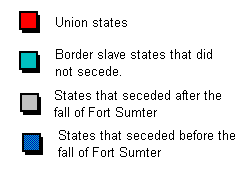
There really where 13 Confederate States. All three national flags of the Confederacy carried 13 stars to represent these states. Yet the history books show 11 Confederate States and 4 border slave states (Marlyland, West Virginia, Kentucky, and Missouri). The situation developed because the United States never recognized the final two states (Missouri and Kentucky) to be in rebellion, although the Confederate States of America did. The Historical Time Illustrated Encylopedia of the Civil War (1986) states in regard to Missouri:
In Oct. 1861, pro-southern legislators met in Neosho, in southwest Missouri, and passed an act of secession 'declaring the ties heretofore existing between the United States and the State of Missouri dissolved.' On that basis, the state was declared by Southerners to be a member of the Confederacy. But a pro-union state convention had already convened in Jefferson City; with the support of the Federal government, it had deposed Jackson [newly elected governor who was stongly pro-south] and his refugee legislators and had set up a new state government.
and in regard to Kentucky:
Kentucky soldiers in the Confederate army held a convention at Russelville Nov. 1861 and adopted an ordinance of secession. With a pro-South governor and a largely pro-North legislature, the state reeled in confusion.
Katcher and Scollins (1994) state, "Missouri's addition on 28 November gave the flag 12 stars, while the final number of 13 was reached on 10 December with Kentucky's joining the Southern States." In both of these states, two separate provisional governments were organized, and the southern sympathizers voted to secede. The Confederacy recognized their actions (wanting as many states as possible), but the United States govenment did not since the vote was unrepresentative of the entire state. The actions of the Confederate government was illegal in accepting the vote of two provisional govenments. The United States government was correct in not accepting Kentucky and Missouri to be in rebellion and regarding them as border states. That, however, does not alter the fact that the Confederate governement did consider them southern states, hence the 13 stars on their flags.

Sources: "The Historical Time Illustrated Encylopedia of the Civil War", 1986; "Flags of the American Civil War: Confederate" by Philip Katcher and Rick Scollins, Osprey Publishing Ltd., London, 1992.
| Return to the Lobby |